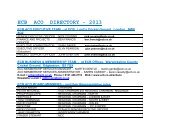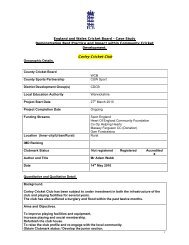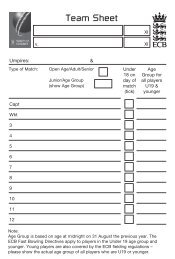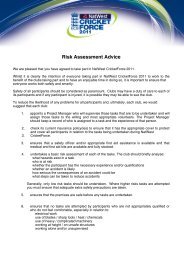Developing a Project â From Concept to Completion - Ecb - England ...
Developing a Project â From Concept to Completion - Ecb - England ...
Developing a Project â From Concept to Completion - Ecb - England ...
- No tags were found...
You also want an ePaper? Increase the reach of your titles
YUMPU automatically turns print PDFs into web optimized ePapers that Google loves.
13Table 1 – Design Work StagesMain Stage Work Stage Brief DescriptionPreparationAAppraisalThe applicants needs and objectives are identified along with the business case and any possibleconstraints on the development Feasibility studies should be prepared and the options assessedby the applicant <strong>to</strong> enable them <strong>to</strong> decide whether <strong>to</strong> proceed. Documenting some ideas andoptions with approximate costs can be done relatively inexpensively.BDesign BriefAt this stage key requirement, constraints, procurement methods and consultants are identified.The range of professional consultants and skills required will depend on the project size and itscomplexity, as outlined in Section 6 of this document.DesignCDE<strong>Concept</strong>Design DevelopmentTechnical DesignThe design stage is divided in<strong>to</strong> three: stage C, <strong>Concept</strong> Design is where outline proposals,specifications and cost plans are prepared and the procurement route is reviewed. The design isdeveloped further in stage D and this is when planning applications are typically (but not always)submitted. Stage E is when the technical designs and specifications are developed sufficiently <strong>to</strong>coordinate all the different elements of the project. Once a project is underway the lead consultantwill guide you through the subsequent work stages which all require client sign-off. Allow time <strong>to</strong>review the drawings and reports prepared by the design team, checking your requirements againstthe design. Early changes and requests are much easier <strong>to</strong> accommodate whereas latechanges can have cost implications out of scale with the amendments.Pre-ConstructionFGHProduct InformationTender DocumentationTender ActionThe pre-construction stage is also divided in<strong>to</strong> three: F/ Production Information is when detailedinformation for construction is prepared and submitted <strong>to</strong> building control for approval.G/ Tender Documentation is the preparation and collation of sufficient information <strong>to</strong> enabletenders <strong>to</strong> be obtained. In this instance, a tender is an offer by a contrac<strong>to</strong>r <strong>to</strong> execute the work ata fixed price. H/ Tender Action are when potential contrac<strong>to</strong>rs and specialists are identified andevaluated, then invited <strong>to</strong> prepare tenders. Once tenders are obtained and appraised, the designteam will submit their recommendations <strong>to</strong> the client. Compiling the list of potential contrac<strong>to</strong>rs willoften start well in advance of the tender period.ConstructionIJConstruction MobilisationConstruction <strong>to</strong> Practical <strong>Completion</strong>The construction stage is divided in<strong>to</strong> two: J/ Mobilisation are when the contract is let, thecontrac<strong>to</strong>r appointed, construction information is issued <strong>to</strong> the contrac<strong>to</strong>r and the site is handedover by the client. The contrac<strong>to</strong>r will need time <strong>to</strong> prepare before starting on site, for example,they will organise their construction team, place orders for materials and arrange sub-contracts.K/ Construction are when the contract is administered and the project is built (or refurbished).The design team will issue further information <strong>to</strong> the contrac<strong>to</strong>r if required and also reviewinformation prepared by the contrac<strong>to</strong>r or any specialists.Use K Post Practical <strong>Completion</strong>The final stage is using the new facilities. The completed project is handed over <strong>to</strong> the client andthe contrac<strong>to</strong>r leaves site. Some contract administration takes place after practical completionincluding making final inspections after the defects liability period. The clients might requiresome assistance during initial occupation period, for example, maintenance.14 Sources <strong>Developing</strong> of Grant a <strong>Project</strong> Aid – and <strong>From</strong> Funding <strong>Concept</strong> for Cricket <strong>to</strong> <strong>Completion</strong> Clubs<strong>Developing</strong> Sources of a Grant <strong>Project</strong> Aid – and <strong>From</strong> Funding <strong>Concept</strong> for <strong>to</strong> Cricket <strong>Completion</strong> Clubs 15












![Indoor Sports Halls with Cricket Provision [TS3] - Ecb - England and ...](https://img.yumpu.com/49070696/1/190x135/indoor-sports-halls-with-cricket-provision-ts3-ecb-england-and-.jpg?quality=85)



